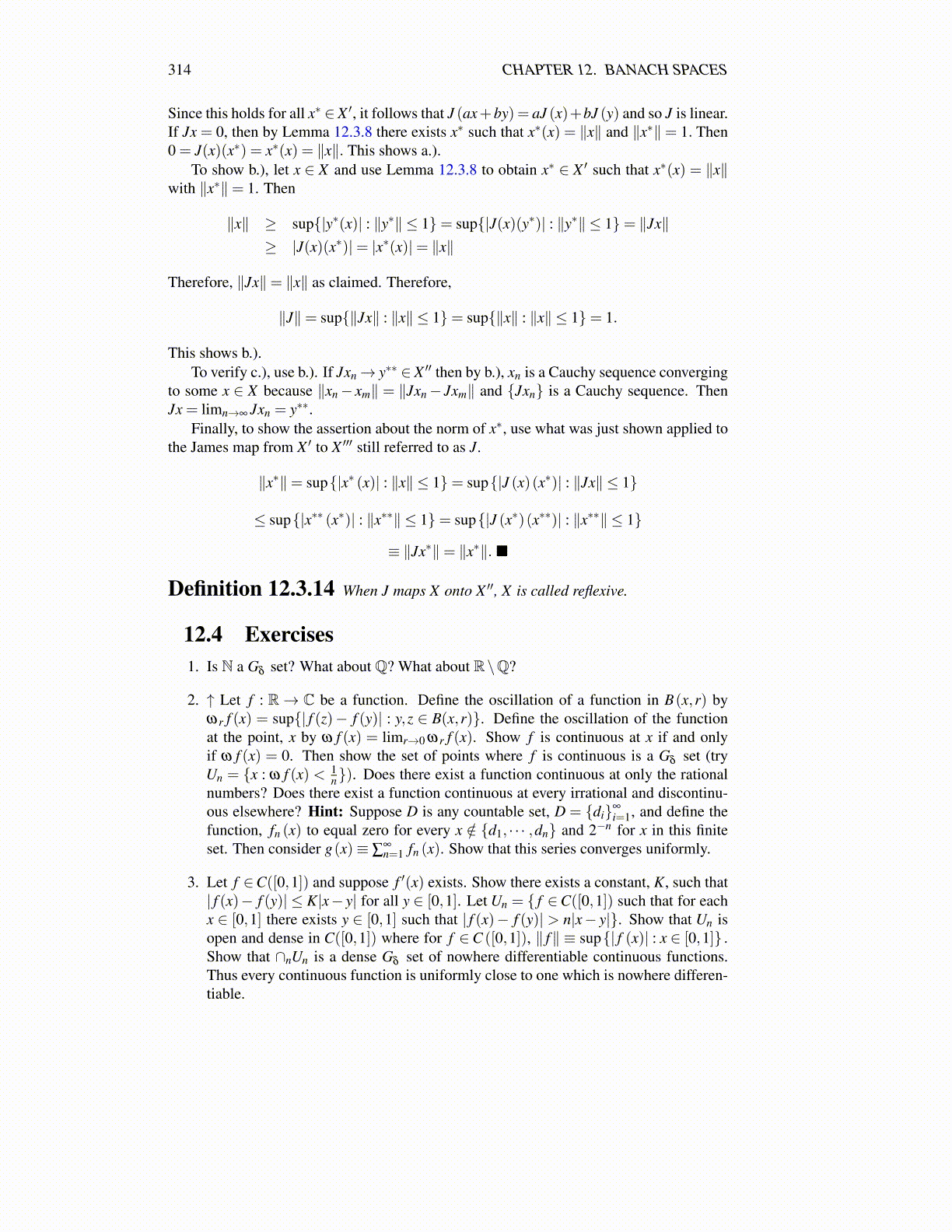
314 CHAPTER 12. BANACH SPACES
Since this holds for all x∗ ∈ X ′, it follows that J (ax+by) = aJ (x)+bJ (y) and so J is linear.If Jx = 0, then by Lemma 12.3.8 there exists x∗ such that x∗(x) = ∥x∥ and ∥x∗∥= 1. Then0 = J(x)(x∗) = x∗(x) = ∥x∥. This shows a.).
To show b.), let x ∈ X and use Lemma 12.3.8 to obtain x∗ ∈ X ′ such that x∗(x) = ∥x∥with ∥x∗∥= 1. Then
∥x∥ ≥ sup{|y∗(x)| : ∥y∗∥ ≤ 1}= sup{|J(x)(y∗)| : ∥y∗∥ ≤ 1}= ∥Jx∥≥ |J(x)(x∗)|= |x∗(x)|= ∥x∥
Therefore, ∥Jx∥= ∥x∥ as claimed. Therefore,
∥J∥= sup{∥Jx∥ : ∥x∥ ≤ 1}= sup{∥x∥ : ∥x∥ ≤ 1}= 1.
This shows b.).To verify c.), use b.). If Jxn→ y∗∗ ∈ X ′′ then by b.), xn is a Cauchy sequence converging
to some x ∈ X because ∥xn− xm∥ = ∥Jxn− Jxm∥ and {Jxn} is a Cauchy sequence. ThenJx = limn→∞ Jxn = y∗∗.
Finally, to show the assertion about the norm of x∗, use what was just shown applied tothe James map from X ′ to X ′′′ still referred to as J.
∥x∗∥= sup{|x∗ (x)| : ∥x∥ ≤ 1}= sup{|J (x)(x∗)| : ∥Jx∥ ≤ 1}
≤ sup{|x∗∗ (x∗)| : ∥x∗∗∥ ≤ 1}= sup{|J (x∗)(x∗∗)| : ∥x∗∗∥ ≤ 1}
≡ ∥Jx∗∥= ∥x∗∥. ■
Definition 12.3.14 When J maps X onto X ′′, X is called reflexive.
12.4 Exercises1. Is N a Gδ set? What about Q? What about R\Q?
2. ↑ Let f : R→ C be a function. Define the oscillation of a function in B(x,r) byωr f (x) = sup{| f (z)− f (y)| : y,z ∈ B(x,r)}. Define the oscillation of the functionat the point, x by ω f (x) = limr→0 ωr f (x). Show f is continuous at x if and onlyif ω f (x) = 0. Then show the set of points where f is continuous is a Gδ set (tryUn = {x : ω f (x) < 1
n}). Does there exist a function continuous at only the rationalnumbers? Does there exist a function continuous at every irrational and discontinu-ous elsewhere? Hint: Suppose D is any countable set, D = {di}∞
i=1, and define thefunction, fn (x) to equal zero for every x /∈ {d1, · · · ,dn} and 2−n for x in this finiteset. Then consider g(x)≡ ∑
∞n=1 fn (x). Show that this series converges uniformly.
3. Let f ∈C([0,1]) and suppose f ′(x) exists. Show there exists a constant, K, such that| f (x)− f (y)| ≤ K|x− y| for all y ∈ [0,1]. Let Un = { f ∈C([0,1]) such that for eachx ∈ [0,1] there exists y ∈ [0,1] such that | f (x)− f (y)| > n|x− y|}. Show that Un isopen and dense in C([0,1]) where for f ∈C ([0,1]), ∥ f∥ ≡ sup{| f (x)| : x ∈ [0,1]} .Show that ∩nUn is a dense Gδ set of nowhere differentiable continuous functions.Thus every continuous function is uniformly close to one which is nowhere differen-tiable.